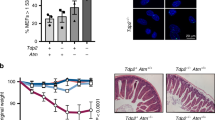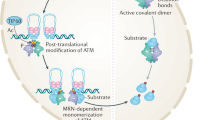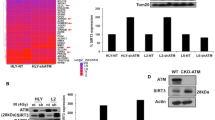Abstract
Ataxia-telangiectasia (AT) is a complex, autosomal recessive disorder characterized by cerebellar ataxia, believed to result from progressive neurodegeneration, and telangiectasia, dilation of blood vessels within the eyes and parts of the facial region. AT patients suffer from recurrent infections caused by both cellular and humoral immune deficiencies and as a population, are significantly predisposed to cancer, particularly lymphomas and leukemias. Early attempts at treating these malignancies with radiotherapy revealed another hallmark of AT, a profound hypersensitivity to the cytotoxic effects of ionizing radiation (IR) which is recapitulated at the cellular level in culture. Predisposition to cancer and radiosensitivity observed in AT has been linked to chromosomal instability, abnormalities in genetic recombination, and defective signaling to programmed cell death and several cell cycle checkpoints activated by DNA damage. These earlier observations predicted that the gene defective in AT may encode a protein which plays a crucial role in sensing DNA damage and transducing signals that promote cell survival. Through the combined efforts of linkage analysis and positional cloning, a single gene was identified on chromosome 11q22-33 by Shiloh and colleagues and was found to be mutated in all four complementation groups previously characterized in cell lines derived from AT patients (,). The predicted ATM gene product shows considerable homology to an emerging family of high molecular weight, phosphatidylinositol -3 kinase (PI-3 K)-related proteins involved in eukaryotic cell cycle control, DNA repair, and DNA recombination (). This landmark discovery has triggered a resurgence of biochemical and genetic studies focusing on ATM function which has brought forth insights regarding ATM activity and its role in DNA damage signaling.
This is a preview of subscription content, access via your institution
Access options
Subscribe to this journal
Receive 50 print issues and online access
$259.00 per year
only $5.18 per issue
Buy this article
- Purchase on Springer Link
- Instant access to full article PDF
Prices may be subject to local taxes which are calculated during checkout
Similar content being viewed by others
Author information
Authors and Affiliations
Rights and permissions
About this article
Cite this article
Canman, C., Lim, DS. The role of ATM in DNA damage responses and cancer. Oncogene 17, 3301–3308 (1998). https://doi.org/10.1038/sj.onc.1202577
Published:
Issue Date:
DOI: https://doi.org/10.1038/sj.onc.1202577
Keywords
This article is cited by
-
The mirror like expression of genes involved in the FOXO signaling pathway could be effective in the pathogenesis of human lymphotropic virus type 1 (HTLV-1) through disruption of the downstream pathways
BMC Research Notes (2023)
-
Sublethal dose of irradiation enhances invasion of malignant glioma cells through p53-MMP 2 pathway in U87MG mouse brain tumor model
Radiation Oncology (2015)
-
Common variants at the 9q22.33, 14q13.3 and ATM loci, and risk of differentiated thyroid cancer in the Cuban population
BMC Genetics (2015)
-
Induction of G2/M arrest by pseudolaric acid B is mediated by activation of the ATM signaling pathway
Acta Pharmacologica Sinica (2009)
-
Differential Expression of Small Heat Shock Protein 27 (Hsp27) in Ataxia telangiectasia Brains
Neurochemical Research (2009)



